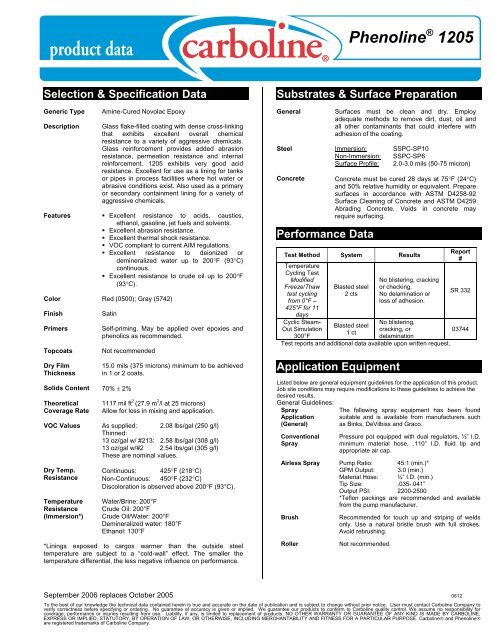English (United Kingdom) - Paul Wurth
English (United Kingdom) - Paul Wurth
English (United Kingdom) - Paul Wurth
- TAGS
- wurth
- www.paulwurth.com
Create successful ePaper yourself
Turn your PDF publications into a flip-book with our unique Google optimized e-Paper software.
Selection & Specification Data<br />
Generic Type Amine-Cured Novolac Epoxy<br />
Description Glass flake-filled coating with dense cross-linking<br />
that exhibits excellent overall chemical<br />
resistance to a variety of aggressive chemicals.<br />
Glass reinforcement provides added abrasion<br />
resistance, permeation resistance and internal<br />
reinforcement. 1205 exhibits very good acid<br />
resistance. Excellent for use as a lining for tanks<br />
or pipes in process facilities where hot water or<br />
abrasive conditions exist. Also used as a primary<br />
or secondary containment lining for a variety of<br />
aggressive chemicals.<br />
Features � Excellent resistance to acids, caustics,<br />
ethanol, gasoline, jet fuels and solvents.<br />
� Excellent abrasion resistance.<br />
� Excellent thermal shock resistance.<br />
� VOC compliant to current AIM regulations.<br />
� Excellent resistance to deionized or<br />
demineralized water up to 200°F (93°C)<br />
continuous.<br />
� Excellent resistance to crude oil up to 200°F<br />
(93°C).<br />
Color Red (0500); Gray (5742)<br />
Finish Satin<br />
Primers Self-priming. May be applied over epoxies and<br />
phenolics as recommended.<br />
Topcoats Not recommended<br />
Dry Film<br />
Thickness<br />
Solids Content 70% ± 2%<br />
Theoretical<br />
Coverage Rate<br />
15.0 mils (375 microns) minimum to be achieved<br />
in 1 or 2 coats.<br />
1117 mil ft 2 (27.9 m 2 /l at 25 microns)<br />
Allow for loss in mixing and application.<br />
VOC Values As supplied: 2.08 lbs/gal (250 g/l)<br />
Thinned:<br />
13 oz/gal w/ #213: 2.58 lbs/gal (308 g/l)<br />
13 oz/gal w/#2 2.54 lbs/gal (305 g/l)<br />
These are nominal values.<br />
Dry Temp.<br />
Resistance<br />
Temperature<br />
Resistance<br />
(Immersion*)<br />
Continuous: 425°F (218°C)<br />
Non-Continuous: 450°F (232°C)<br />
Discoloration is observed above 200°F (93°C).<br />
Water/Brine: 200°F<br />
Crude Oil: 200°F<br />
Crude Oil/Water: 200°F<br />
Demineralized water: 180°F<br />
Ethanol: 130°F<br />
*Linings exposed to cargos warmer than the outside steel<br />
temperature are subject to a “cold-wall” effect. The smaller the<br />
temperature differential, the less negative influence on performance.<br />
Phenoline ® 1205<br />
Substrates & Surface Preparation<br />
General Surfaces must be clean and dry. Employ<br />
adequate methods to remove dirt, dust, oil and<br />
all other contaminants that could interfere with<br />
adhesion of the coating.<br />
Steel Immersion: SSPC-SP10<br />
Non-Immersion: SSPC-SP6<br />
Surface Profile: 2.0-3.0 mils (50-75 micron)<br />
Concrete Concrete must be cured 28 days at 75°F (24°C)<br />
and 50% relative humidity or equivalent. Prepare<br />
surfaces in accordance with ASTM D4258-92<br />
Surface Cleaning of Concrete and ASTM D4259<br />
Abrading Concrete. Voids in concrete may<br />
require surfacing.<br />
Performance Data<br />
Test Method System Results<br />
Temperature<br />
Cycling Test<br />
Modified<br />
Freeze/Thaw<br />
test cycling<br />
from 0°F –<br />
425°F for 11<br />
days<br />
Cyclic Steam-<br />
Out Simulation<br />
300°F<br />
Blasted steel<br />
2 cts<br />
Blasted steel<br />
1 ct<br />
No blistering, cracking<br />
or checking.<br />
No delamination or<br />
loss of adhesion.<br />
No blistering,<br />
cracking, or<br />
delamination<br />
Test reports and additional data available upon written request.<br />
Application Equipment<br />
September 2006 replaces October 2005 0612<br />
To the best of our knowledge the technical data contained herein is true and accurate on the date of publication and is subject to change without prior notice. User must contact Carboline Company to<br />
verify correctness before specifying or ordering. No guarantee of accuracy is given or implied. We guarantee our products to conform to Carboline quality control. We assume no responsibility for<br />
coverage, performance or injuries resulting from use. Liability, if any, is limited to replacement of products. NO OTHER WARRANTY OR GUARANTEE OF ANY KIND IS MADE BY CARBOLINE,<br />
EXPRESS OR IMPLIED, STATUTORY, BY OPERATION OF LAW, OR OTHERWISE, INCLUDING MERCHANTABILITY AND FITNESS FOR A PARTICULAR PURPOSE. Carboline® and Phenoline®<br />
are registered trademarks of Carboline Company.<br />
Report<br />
#<br />
SR 332<br />
03744<br />
Listed below are general equipment guidelines for the application of this product.<br />
Job site conditions may require modifications to these guidelines to achieve the<br />
desired results.<br />
General Guidelines:<br />
Spray<br />
Application<br />
(General)<br />
Conventional<br />
Spray<br />
The following spray equipment has been found<br />
suitable and is available from manufacturers such<br />
as Binks, DeVilbiss and Graco.<br />
Pressure pot equipped with dual regulators, ½” I.D.<br />
minimum material hose, .110” I.D. fluid tip and<br />
appropriate air cap.<br />
Airless Spray Pump Ratio: 45:1 (min.)*<br />
GPM Output: 3.0 (min.)<br />
Material Hose: ½” I.D. (min.)<br />
Tip Size: .035-.041”<br />
Output PSI: 2200-2500<br />
*Teflon packings are recommended and available<br />
from the pump manufacturer.<br />
Brush Recommended for touch up and striping of welds<br />
only. Use a natural bristle brush with full strokes.<br />
Avoid rebrushing.<br />
Roller Not recommended.




